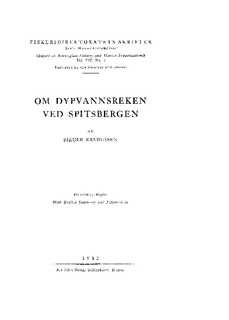| dc.description.abstract | The life history of the deep sea prawn, Pandalus borealis, in Spitsbergen
waters is traced on the basis af samples collected mainly in
1938 and 1939. In measuring the prawn a different method than that
used by previous authors has been employed, as instead of the total
length, the length of the carapace without the rostrum has been measured
(see fig. 2). The measurement is taken in millimeters from the base
of the eye to the posterior edge of the carapace. For comparison of
the measurements thus obtained with the results of previous authors
stating the total length of the prawn, the length of the carapace is
multiplied by the factor 5,3 which is the average of nunmerous control
measurements.
The adult females carrying eggs are fouild as early as in July, but
the main spawning of the Spitsbergen prawn takes place in August-
September. The females with hatching eggs are found during the
following May-June, and the egg-bearing period is estimated to last
about 9 months.
The smallest bottom stages of the prawn have been caught in the
shrimp trawl at the end of June and beginning of July, and they measured
averagely about 39 mm. These small individuals cannot have been
hatched the same summer, and they are therefore considered to be
1 year old. Next summer, when the prawn is 2 years old, it has reached
an average total length of about 62 mm. When the prawn is 3 years
old it is on the average about 85 mm long in the summer and it matures
as a functioning male the same autumn. The Spitsbergen prawn thus
reaches maturity as male at the same size as the prawn in southern
Norwegian waters, but this latter is by then only 1 year old. When
the Spitshergen prawn is 4 years old it has reached an average total
length of about 103 mm and it participates in the spawning as male
for the second time.
The following spring and summer the male prawn goes through
the transitional stages, and in autumn they reach the maturity of females
and become ovigerous. The Spitsbergen prawn can also spawn
before all the transitional stages are completed. Thus ovigerous females
in transitional stage C and D (fig. 4) are not infrequent in the catches.
The Spitsbergen prawns are 5 years old when they spawn for the first
time, and they have then reached an average total length of about
117 mm, i. e. the same size as prawns in the corresponding stage of
maturity in southern Norwegian waters, but the Spitsbergen prawn is
by then 3 years older than the southern prawn. In the Spitsbergen
prawn there is no apparent difference in size between the transition
individuals and the first time spawners. In fig. 6 are represented the
size of the various age grtiops of the prawn up to first time spawners.
The female prawns carry their eggs all winter, and at the end of
May and beginning of June the ovigerous prawns can still be found
with hatching eggs, or the hatching is just completed. The major part
of these females does not seem to become ovigerous again the same
autumn, but enters apparantly a period of sexual rest. During the
summer, after moulting, they can be sorted out in the catches as females
with undeveloped ovaries. These prawns are by then 6 years old, and
have an average total length of about 123 mm. These old female prawns
apparently become sexually mature again during the following winter
and spring, and they are in the summer found as large females with
ripening ovaries. They should thus spawn for the second time when
they are 7 years old after 1 year of sexual rest. These older prawns
also seem to become ovigerous later in the autumn than do the first
time spawners (fig. 7 C).
The rate of growth of the Spitsbergen prawn compared with the
growth of the prawn in southern Norwegian waters is illustrated in
fig. 9. | en |
